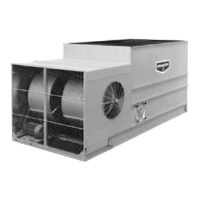16
Operation and Maintenance Instructions
Water Treatment and Water Chemistry of the Recirculated Water System
It is recommended that a qualified water treatment company be contacted to design a water treatment protocol specifically for
equipment and location. Contact your local EVAPCO representative for assistance.
Evaporative cooling equipment rejects heat by evaporating a portion of the recirculated water and discharging it into the
atmosphere in the hot, saturated discharge air. As the water evaporates, it leaves behind all the mineral content and impurities. If
the water chemistry is not controlled properly, the residuals may become concentrated and lead to corrosion, scaling, sludge build
up and biological fouling. Corrosion would be identified as red rust on steel components or white rust on galvanized steel.
Corrosion will adversely affect the longevity of the tower. Scale reduces heat transfer efficiency and system efficiency, while scale
and sludge can both lead to under deposit corrosion. Biological fouling such as slime and algae may reduce the unitʼs heat
transfer, promote corrosion and possibly harbor pathogens such as Legionella Pneumophila.
Bleed Off
As a minimum, to avoid the build up of residuals in the water distribution system, water must be drained out of the system at a rate
large enough to the control the system water chemistry. The maximum amount of bleed is equal to the rate of evaporation based
on 2 cycles of concentration.
Open cooling towers need to have a bleed line installed on the discharge side of the system pump. A metering device and globe
valve should also be provided. The metering device is used to determine the bleed water volume. The globe valve is used to
regulate flow.
Another method to remove residuals is to use a conductivity controlled blowdown device. This method should also be considered
for water savings.
Biological Contamination
Water quality should be checked regularly for biological contamination. If biological contamination is detected, a more aggressive
water treatment and mechanical cleaning program is required. The water treatment program should be performed in conjunction
with a qualified water treatment company. It is important that all internal surfaces be kept clean of accumulated dirt or sludge. In
addition, the drift eliminators should be kept in good operating condition to minimize water from exiting the evaporative cooling unit
in the discharge air.
To minimize the risk of biological contamination, at initial start up or after an extended shut down, it is recommended that the entire
system (cooling tower, system piping, heat exchanger, etc.) be properly treated. Clean all debris such as leaves and dirt from the
unit. Completely fill the basin to the overflow level with fresh water. Initiate a biocide water treatment or shock treatment program
prior to operating the unit. It is preferable that all such procedures be conducted or supervised by a water treatment specialist.
Air Contamination
If the unit is located in an area where there are contaminents such as: chemical fumes, industrial smoke, salt or heavy dust, the
impurities in the air will be washed out in the recirculated water and may cause scaling, corrosion or accelerated biological growth.
It is important not to locate the unit next to smokestacks, discharge ducts, vents, flue gas exhausts, etc. because the unit will draw
in these fumes which may lead to extremely corrosive conditions. It is also important to locate the unit away from the buildingʼs
fresh air intakes to prevent any drift or other unit discharge from entering the buildingʼs air system. The quantity of impurities in the
air will determine the frequency of the maintenance program. Bleeding off the impurities will help, but if there are any signs of
corrosion, scaling or biological growth, the qualified water treatment specialist should be contacted.

